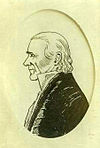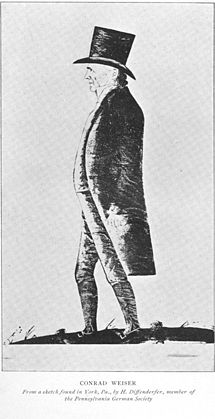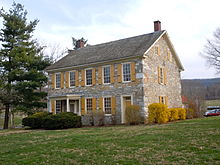- Conrad Weiser
-
Conrad Weiser 
Born Johann Conrad Weiser, Jr.
November 2, 1696Died July 13, 1760 (aged 63) Religion Lutheran Spouse Anna Eve Feck Parents Johann Conrad Weiser, Sr.
Anna Magdalena UebeleSignature 
Conrad Weiser (November 2, 1696 – July 13, 1760), born Johann Conrad Weiser, Jr., was a Pennsylvania German (a.k.a., Pennsylvania Dutch) pioneer, interpreter and effective diplomat between the Pennsylvania Colony and Native Americans. He was a farmer, soldier, monk, tanner, and judge as well. He contributed as an emissary in councils between Native Americans and the colonies, especially Pennsylvania, during the 18th century's tensions of the French and Indian War (Seven Years' War).
Contents
Early years
Conrad Weiser was born in 1696 in the small village of Affstätt in Herrenberg, in the Duchy of Württemberg (now part of Germany), where his father (Johann Conrad Weiser, Sr.) was stationed as a member of the Württemberg Blue Dragoons. Soon after Conrad's birth, his father received a discharge from the Blue Dragoons and moved back to the family ancestral home of Großaspach. In 1709 fever claimed the life of his mother, Anna Magdalena, after the land and people were ravaged by French invasions related to religious wars, pestilence, and an unusually cold and long winter. Conrad Weiser (senior) wrote for his children, "Buried beside Her Ancestors, she was a god-fearing woman and much loved by Her neighbors. Her motto was Jesus I live for thee, I die for thee, thine am I in life and death."[1]
Conrad Weiser and his family were among thousands of refugees who left German lands that year, many of them from the Palatine area. They traveled down the Rhine River and then to England, which had offered some support for the Protestant refugees. Thousands of Palatine German refugees made their way to London seeking escape from the harsh conditions; there were so many that the English had to make a camp for them outside the London walls for the winter. The following year in 1710, the Crown (under Queen Anne) arranged for transport in ten ships of the nearly 3,000 Germans to the New York colony. The Crown supported migration of the immigrants to help settle the New York colony. The plan was that they would work off their passage in a form of indenture in camps devoted to producing ships' stores, such as tar and other materials. Later they would be allowed to trade their work for land. Most of the Germans were first located in what were called the East and West Camps on the Hudson River, near Livingston Manor. It was not until 1723 that some 100 heads of families received land grants in the central Mohawk Valley, under Governor Burnetsfield.
Weiser senior managed to get his family to the Schoharie Valley earlier than that. When Conrad was 16, his father agreed to a chief's proposal for the youth to live with the Mohawks in the upper Schoharie Valley. During his stay in the winter and spring of 1712-1713, Weiser learned much about the Mohawk language and the customs of the Iroquois, while enduring hardships of cold, hunger, and homesickness. Conrad Weiser returned to his own people towards the end of July 1713.
On November 22, 1720, at the age of 24, Weiser married the young German girl Anna Eve Feck (Faeg). In 1723 the couple followed the Susquehanna River south out of New York and settled their young family on a farm in Womelsdorf, Pennsylvania near present-day Reading. The couple had fourteen children, of which only seven reached adulthood.
Service
Weiser's colonial service began in 1731. The Iroquois sent Shikellamy, an Oneida chief, as an emissary to other tribes and the British. Shikellamy lived on the Susquehanna River at Shamokin village, near present-day Sunbury, Pennsylvania. An oral tradition holds that Weiser met Shikellamy while hunting. In any case, the two became friends. When Shikellamy traveled to Philadelphia for a council with the province of Pennsylvania, he brought Weiser with him. The Iroquois trusted him and considered him an adopted son of the Mohawks. Weiser impressed the Pennsylvania governor and council, which thereafter relied heavily on his services. Weiser also interpreted in a follow-up council in Philadelphia in August, 1732.
During the treaty in Philadelphia of 1736, Shikellamy, Weiser and the Pennsylvanians negotiated a deed whereby the Iroquois sold the land drained by the Delaware River and south of the Blue Mountain. Since the Iroquois had not until then laid claim to this land, Pennsylvania's agreement to purchase from them represented a significant change in the colony's policy toward the Native Americans. William Penn had never taken sides in disputes between tribes. By this formal purchase, the Pennsylvanians were favoring the Iroquois over the claims of the Lenape/Delawares for the same land. Along with the Walking Purchase of the following year, Penn's treaty exacerbated Pennsylvania-Lenape relations. The Lenapes became disenchanted with the English colonials as a result; during the French and Indian Wars, they sided with the French and caused many colonial deaths. Penn's purchase persuaded the Iroquois to continue to side with the British over the French.
During the winter of 1737, Weiser attempted to broker a peace between southern tribes and the Iroquois. He had to survive high snow, freezing temperatures and starvation rations just to make the six-week journey to the Iroquois capital of Onondago. Weiser persuaded the Iroquois not to send any war parties in the spring, but he failed to convince them to send emissaries to parlay with the southern tribes. Impressed with his fortitude, the Iroquois named Weiser Tarachiawagon (Holder of the Heavens). Spill-over violence from a war between the Iroquois and southern tribes such as the Catawba would have drawn first Virginia, and then Pennsylvania, into conflict with the Iroquois. Therefore this peace-brokering had a profound effect on Native American/colonial relations.
In 1742, Weiser interpreted at a treaty meeting between the Iroquois and English colonials at Philadelphia, when they were paid for the land purchased in 1736. During this council, the Iroquois Onondaga chief Canasatego castigated the Lenape/Delawares for engaging in land sales. He ordered them to remove their settlements to either Wyoming or Shamokin village. This accelerated the Lenape migration to the Ohio Valley, which had begun as early as the 1720s. There, they were positioned to trade with the French. At the same time, they launched raids as far east as the Susquehanna River during the French and Indian Wars.
In 1744, Weiser acted as the interpreter for the Treaty of Lancaster, between representatives of the Iroquois and the colonies of Pennsylvania, Maryland and Virginia. During the final day of the treaty, on July 4, Canasatego, the Onondaga chief, spoke of the Iroquois concepts of political unity:
"Our wise forefathers established Union and Amity between the Five Nations. This has made us formidable; this has given us great Weight and Authority with our neighboring Nations. We are a powerful Confederacy; and by your observing the same methods, our wise forefathers have taken, you will acquire such Strength and power. Therefore whatever befalls you, never fall out with one another."
Benjamin Franklin printed this speech, which influenced American concepts of political unity.
After the Treaty of Lancaster, both the Virginia and Pennsylvania colonial officials acted as if the Iroquois had sold them settlement rights to the Ohio Valley, but the Iroquois did not believe they had done so. In 1748, Pennsylvania sent Conrad Weiser to Logstown, a council and trade village on the Ohio River. Here he held council with chiefs representing 10 tribes, including Delawares, Shawnees, and the Iroquois. He arrived at a treaty of friendship between Pennsylvania and these tribes. Threatened by this development and the continued activity of British traders in the Ohio Valley, the French redoubled their diplomatic efforts. In addition, they began to build a string of forts to protect their interests, culminating in Fort Duquesne in 1754 at present-day Pittsburgh.
In 1750, Weiser traveled again to Onondaga, where he found the political dynamics in the Six Nations had shifted. Canasatego, always pro-British, had died. Several Iroquois tribes were leaning toward the French, although the Mohawks remained pro-British.
Early in the summer of 1754, on the eve of the eruption in the colonies of tensions from the Seven Years' War, called the French and Indian War in North America, Weiser was a member of a Pennsylvania delegation to Albany. The English government had called the meeting, hoping to win assurances of Iroquois support in the looming war with the French. Present were representatives of the Iroquois and seven colonies. Because of divisions within both the British and Native American ranks, the council did not result in the treaty of support which the crown desired. Instead, each colony made the best deal it could with individual Iroquois leaders.
Conrad Weiser was able to negotiate one of the more successful agreements. Some lower-level chiefs deeded to the colony most of the land remaining in present-day Pennsylvania, including the southwestern part still claimed by Virginia.
In 1756, the government appointed Weiser and Ben Franklin to lead construction of a series of forts between the Delaware River and the Susquehanna River. In the fall of 1758, Weiser attended a council at Easton, Pennsylvania. Representation included colonial leaders from Pennsylvania, the Iroquois and other Native American tribes. Weiser helped smooth over the tense meeting. With the Treaty of Easton, the tribes in the Ohio Valley agreed to abandon support for the French. This collapse of Native American support was a factor in the French decision to demolish Fort Duquesne and withdraw from the Forks of the Ohio.
Throughout his decades-long career, Weiser built on his knowledge of Native American languages and culture. He was a key player in treaty negotiations, land purchases, and the formulation of Pennsylvania's policies towards Native Americans. Because of his early experiences with the Iroquois, Weiser was inclined to be sympathetic to their interpretation of events, as opposed to the Lenape or the Shawnees. This may have exacerbated Pennsylvanian-Lenape/Shawnee relations, with bloody consequences in the French and Indian Wars.
Nevertheless, for many years, Weiser helped to keep the powerful Iroquois allied with the British as opposed to the French. This important service contributed to the continued survival of the British colonies and the eventual victory of the British over the French in the French and Indian Wars.
Other careers
Between 1734 and 1741, Weiser became a follower of Conrad Beissel, a German Seventh Day Baptist preacher. For six years, he lived at the monastic settlement, Ephrata Cloister, in the Ephrata Township, Lancaster County, Pennsylvania. His wife lived there only a few months before returning to their farm. Weiser visited her frequently enough to father four more children. In addition, he took leaves of absence from the monastery for diplomatic duties, such as those in 1736 and 1737.
Like many other colonists, Weiser combined farming with other trades: land owner and speculator, tanner, and merchant. He created the plan for the town of Reading in 1748, was a key figure in the creation of Berks County in 1752, and served as its chief judge until 1760. Conrad was also teacher and a lay minister of the Lutheran Church; he was one of the founders of Trinity Church in Reading.
In 1756, during the French and Indian War, the Lenape began to raid central Pennsylvania. When the colony organized a militia, its leaders appointed Weiser as a Lt. Colonel. Working with Benjamin Franklin, he planned and established a series of forts between the Delaware and Susquehanna Rivers. When General Forbes evicted the French from Fort Duquesne in 1758, the threat subsided and Britain later gained all territory east of the Mississippi River at the Treaty of Paris following their success in the Seven Years War.
Death and legacy
Weiser died on his farm on July 13, 1760. Upon his death, one Iroquois Indian noted to a group of colonists, "We are at a great loss and sit in darkness...as since his death we cannot so well understand one another."[citation needed] Indeed, shortly after Conrad Weiser's death, relations between the colonists and the Native Americans began a rapid decline.
Weiser's will bequeathed about 4,000 acres (16 km²) and part of his farm to Berks County. It serves as an interpretive center for 18th century farming, political and colonial history, and hosts regular re-enactments of events during the French and Indian War. The property is administered as a state park.
Weiser and Anna's descendants continued to play roles in civic life. Their daughter Maria married Henry Muhlenberg. Two of their sons had important roles in gaining independence for the United States. Peter Muhlenberg served as a Major General in the Continental Army, and Frederick Muhlenberg was the first Speaker of the United States House of Representatives. A great-grandson Peter M. Weiser (born 1781) was a member of the Corps of Discovery on the Lewis and Clark Expedition in 1804-1806.
Places named for Conrad Weiser
Weiser's major contribution to history was his service as an emissary between the British colonies and the Native Americans, especially the Iroquois. This service had direct and powerful influence over the histories of the French and British empires, the Native American peoples, and the United States.
- The Conrad Weiser Homestead in Womelsdorf has been preserved as a state historic site and is administered by the Pennsylvania Historical and Museum Commission. Weiser and his family were buried at the homestead. The property is on Pennsylvania Route 422 in Berks County. The site contains original and historic buildings on a 26 acres (0.11 km2) site with grounds designed by the Olmsted Brothers in 1928. Due to state budget cutbacks, the PHMC announced that it would close public access to the buildings. [1]
- Camp Conrad Weiser [2] is a 500-acre (2.0 km2) YMCA overnight camp in Berks County. Founded in 1948, it serves boys and girls aged six to sixteen.
- Conrad Weiser Area School District in western Berks County serves the townships of South Heidelberg Township, Heidelberg Township, North Heidelberg Township, and Marion Township, and the boroughs of Wernersville, Robesonia, and Womelsdorf.
- The Weiser State Forest occupies 17,961 acres (72.69 km²) on several tracts in Carbon, Coulmbia, Dauphin, Northumberland, and Schuylkill counties in southeastern Pennsylvania. However, since the realignment of Pennsylvania State Forest Districts on July 1, 2005, northern Berks County is no longer part of Weiser State Forest District #18.
Veneration
Weiser is honored with a feast day on the liturgical calendar of the Episcopal Church (USA) on July 13.
See also
References
- ^ Paul A. W. Wallace, Conrad Weiser, 1696-1760, Friend of Colonist and Mohawk. Philadelphia: University of Pennsylvania Press, 1945. Reprinted Wennawoods, 2001, ISBN 1-889037-06-0
Further reading
- Walton, Joseph S. Conrad Weiser & the Indian Policy of Colonial Pennsylvania. Philadelphia: George W. Jacobs & Co., 1900. Reprinted New York: Arno Press, 1971, ISBN 0-405028-95-4.
- Weiser, J. Conrad Early Western Journals, 1748-1765. 1904. Reprinted Wendawoods, 1998, ISBN 1-889037-12-5.
- Weiser, C. Z. The life of (John) Conrad Weiser, the German pioneer, patriot, and patron of two races. Reading: D. Miller, 1899. Reprinted Whitefish: Kessinger Publishing, 2004, ISBN 1-417967-74-9
External links
- Philip E. Pendelton, "Conrad Weiser Homestead: Finding a Light Into the Forest", Pennsylvania Heritage Magazine, Volume XXII, Number 3 - Summer 1996, e-text, The Pennsylvania Historical and Museum Commission Website
- "Conrad Weiser", Berks County Website
- The Homestead Park
- The Ephrata Cloister site
- "Conrad Weiser", Pennsylvania State Archives
- "Last Day of the Lancaster Treaty Council", Simpson College, IA
- Joseph S. Walton, Conrad Weiser and the Indian Policy of Colonial Pennsylvania, 1900, University of Pittsburgh, Historic Pittsburgh Website. (Weiser's importance in colonial relations with the Iroquois, p. 13. The effect of the 1736 treaties, pp. 27–29. His pro-Iroquois inclination, p. 56.)
- John Conrad Weiser Jr. Evangelical Lutheran Church in America
- [3] Reading Eagle article on closing of Daniel Boone and Conrad Weiser Homesteads
- The Weiser Family Association
Categories:- 1696 births
- 1760 deaths
- People from Herrenberg
- German Lutherans
- American Lutherans
- American translators
- Colonial American Indian agents
- German emigrants to the Thirteen Colonies
- Interpreters
- Pennsylvania colonial people
- People of Pennsylvania in the French and Indian War
- Anglican saints
Wikimedia Foundation. 2010.



